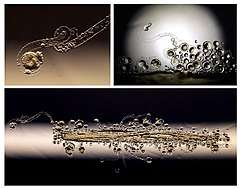Cytophaga
Cytophaga is a genus of Gram-negative, gliding, rod-shaped bacteria. This bacterium is commonly found in soil, rapidly digests crystalline cellulose[1] C. hutchinsonii is able to use its gliding motility to move quickly over surfaces. Although the mechanism for this is not known, there is a belief that the flagella is not used [2]
| Cytophaga | |
|---|---|
 | |
| Cytophaga image. | |
| Scientific classification | |
| Kingdom: | Bacteria |
| Phylum: | |
| Class: | |
| Order: | |
| Family: | |
| Genus: | Cytophaga |
| Species | |
|
C. columnaris | |
Species
The following are some species in Cytophaga:
- Cytophaga columnaris — the cause of columnaris disease in salmonid fish, as associated with increased water temperature; it is characterized by white necrotic plaques overlaying skin ulcers; formerly called: Flexibacter columnaris.
- Cytophaga johnsonae — associated with false columnaris disease.
- Cytophaga psychrophila — causes peduncle or cold water disease in Brook trout; predisposed by subnormal water temperature.
- Cytophaga hutchinsonii --- aerobic cellulolytic soil bacterium that is known for its ability to rapidly glide over surfaces. The mechanism of cellulose digestion is not fully known; however, it is known that C. hutchinsonii has multiple cell-associated cellulolytic enzymes.[3]
References
- Home - Cytophaga hutchinsonii ATCC 33406. (n.d.). Retrieved May 02, 2017, from http://genome.jgi.doe.gov/cythu/cythu.home.html
- Home - Cytophaga hutchinsonii ATCC 33406. (n.d.). Retrieved May 02, 2017, from http://genome.jgi.doe.gov/cythu/cythu.home.html
- Zhu, Yongtao; McBride, Mark (2014). "Deletion of the Cytophaga hutchinsonii type IX secretion system gene sprP results in defects in glinding motility and cellulose utilization" (PDF). Appl Microbiol Biotechnol. 98: 763–755. doi:10.1007/s00253-013-5355-2.
- Saunders Comprehensive Veterinary Dictionary (3rd ed.). Elsevier. 2007.
External links
This article is issued from
Wikipedia.
The text is licensed under Creative
Commons - Attribution - Sharealike.
Additional terms may apply for the media files.